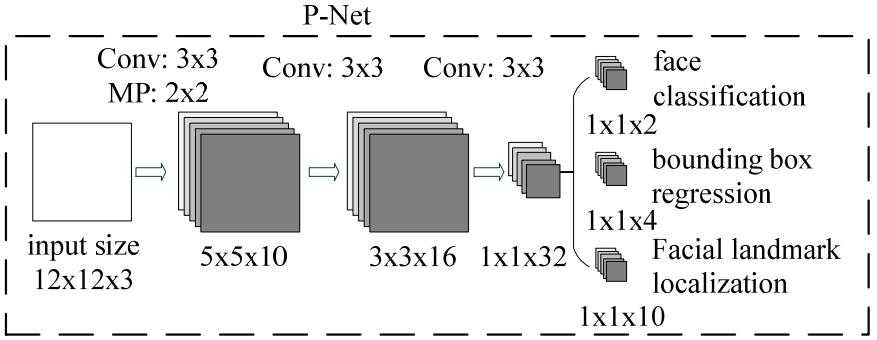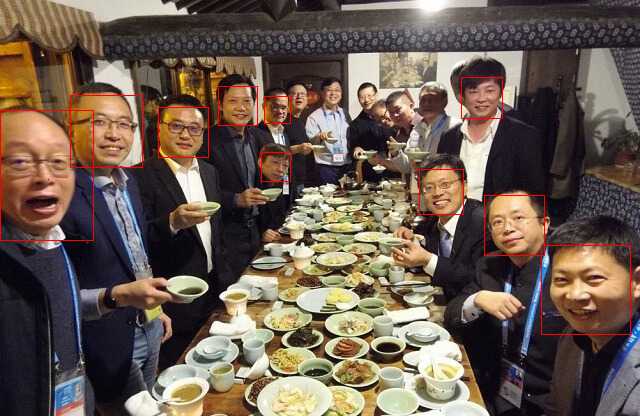标签:make mat else 优劣 const 工作 ifd 没有 fprintf
人脸检测 识别一直是图像算法领域一个主流话题。
前年 SeetaFace 开源了人脸识别引擎,一度成为热门话题。
虽然后来SeetaFace 又放出来 2.0版本,但是,我说但是。。。
没有训练代码,想要自己训练一下模型那可就犯难了。
虽然可以阅读源码,从前向传播的角度,反过来实现训练代码,
但是谁有那个闲功夫和时间,去折腾这个呢?
有的时候还是要站在巨人的肩膀上,你才能看得更远。
而SeetaFace 不算巨人,只是当年风口上的猪罢了。
前年,为了做一个人脸项目,也是看遍了网上各种项目。
林林总总,各有优劣。
不多做评价,很多东西还是要具体实操,实战才能见真知。
有一段时间,用SeetaFace的人脸检测来做一些小的演示demo,
也花了一点小时间去优化它的算法。
不过很明显我只是把他当成玩具看待。
毕竟不能自己训练模型,这是很大的诟病。
直到后来深度学习大放异彩,印象最深刻莫过于MTCNN。
Joint Face Detection and Alignment using Multi-task Cascaded Convolutional Neural Networks
相关资料见:https://github.com/kpzhang93/MTCNN_face_detection_alignment
大合照下,人脸圈出来很准确,壮观了去,这是第一印象。
上图,大家感受一下。
MTCNN的有三个网络结构。
Stage1: Proposal Net

Stage2: Refine Net

Stage3: Output Net

具体算法思路就不展开了。
我对MTCNN感兴趣的点在于,
MTCNN的思路可以拓展到各种物体检测和识别方向。
也许唯一缺少的就是打标好的数据,
而标注五个点,足够用于适配大多数物体了。
符合小而美的理念,这个是我比较推崇的。
所以MTCNN是一个很值得品味的算法。
github上也有不少MTCNN的实现和资源。
基于mxnet 基于caffe 基于ncnn 等等。。。
很明显,mxnet 和 caffe 不符合小而美的理念。
果断抛弃了。
ncnn有点肥大,不合我心。
所以,我动了杀气。。
移除NCNN 与mtcnn无关的层,
梳理ncnn的一些逻辑代码。
简单做了一些适配和优化。
砍掉一些边边角角。
不依赖opencv等第三方库。
编写示例代码完成后,还有不少工作要做,
不过第一步感觉已经符合我的小小预期。
完整示例代码:
#include "mtcnn.h" #include "browse.h" #define USE_SHELL_OPEN #ifndef nullptr #define nullptr 0 #endif #if defined(_MSC_VER) #define _CRT_SECURE_NO_WARNINGS #include <windows.h> #else #include <unistd.h> #endif #define STB_IMAGE_STATIC #define STB_IMAGE_IMPLEMENTATION #include "stb_image.h" //ref:https://github.com/nothings/stb/blob/master/stb_image.h #define TJE_IMPLEMENTATION #include "tiny_jpeg.h" //ref:https://github.com/serge-rgb/TinyJPEG/blob/master/tiny_jpeg.h #include <stdint.h> #include "timing.h" char saveFile[1024]; unsigned char *loadImage(const char *filename, int *Width, int *Height, int *Channels) { return stbi_load(filename, Width, Height, Channels, 0); } void saveImage(const char *filename, int Width, int Height, int Channels, unsigned char *Output) { memcpy(saveFile + strlen(saveFile), filename, strlen(filename)); *(saveFile + strlen(saveFile) + 1) = 0; //保存为jpg if (!tje_encode_to_file(saveFile, Width, Height, Channels, true, Output)) { fprintf(stderr, "save JPEG fail.\n"); return; } #ifdef USE_SHELL_OPEN browse(saveFile); #endif } void splitpath(const char *path, char *drv, char *dir, char *name, char *ext) { const char *end; const char *p; const char *s; if (path[0] && path[1] == ‘:‘) { if (drv) { *drv++ = *path++; *drv++ = *path++; *drv = ‘\0‘; } } else if (drv) *drv = ‘\0‘; for (end = path; *end && *end != ‘:‘;) end++; for (p = end; p > path && *--p != ‘\\‘ && *p != ‘/‘;) if (*p == ‘.‘) { end = p; break; } if (ext) for (s = end; (*ext = *s++);) ext++; for (p = end; p > path;) if (*--p == ‘\\‘ || *p == ‘/‘) { p++; break; } if (name) { for (s = p; s < end;) *name++ = *s++; *name = ‘\0‘; } if (dir) { for (s = path; s < p;) *dir++ = *s++; *dir = ‘\0‘; } } void getCurrentFilePath(const char *filePath, char *saveFile) { char drive[_MAX_DRIVE]; char dir[_MAX_DIR]; char fname[_MAX_FNAME]; char ext[_MAX_EXT]; splitpath(filePath, drive, dir, fname, ext); size_t n = strlen(filePath); memcpy(saveFile, filePath, n); char *cur_saveFile = saveFile + (n - strlen(ext)); cur_saveFile[0] = ‘_‘; cur_saveFile[1] = 0; } void drawPoint(unsigned char *bits, int width, int depth, int x, int y, const uint8_t *color) { for (int i = 0; i < min(depth, 3); ++i) { bits[(y * width + x) * depth + i] = color[i]; } } void drawLine(unsigned char *bits, int width, int depth, int startX, int startY, int endX, int endY, const uint8_t *col) { if (endX == startX) { if (startY > endY) { int a = startY; startY = endY; endY = a; } for (int y = startY; y <= endY; y++) { drawPoint(bits, width, depth, startX, y, col); } } else { float m = 1.0f * (endY - startY) / (endX - startX); int y = 0; if (startX > endX) { int a = startX; startX = endX; endX = a; } for (int x = startX; x <= endX; x++) { y = (int)(m * (x - startX) + startY); drawPoint(bits, width, depth, x, y, col); } } } void drawRectangle(unsigned char *bits, int width, int depth, int x1, int y1, int x2, int y2, const uint8_t *col) { drawLine(bits, width, depth, x1, y1, x2, y1, col); drawLine(bits, width, depth, x2, y1, x2, y2, col); drawLine(bits, width, depth, x2, y2, x1, y2, col); drawLine(bits, width, depth, x1, y2, x1, y1, col); } int main(int argc, char **argv) { printf("mtcnn face detection\n"); printf("blog:http://cpuimage.cnblogs.com/\n"); if (argc < 2) { printf("usage: %s model_path image_file \n ", argv[0]); printf("eg: %s ../models ../sample.jpg \n ", argv[0]); printf("press any key to exit. \n"); getchar(); return 0; } const char *model_path = argv[1]; char *szfile = argv[2]; getCurrentFilePath(szfile, saveFile); int Width = 0; int Height = 0; int Channels = 0; unsigned char *inputImage = loadImage(szfile, &Width, &Height, &Channels); if (inputImage == nullptr || Channels != 3) return -1; ncnn::Mat ncnn_img = ncnn::Mat::from_pixels(inputImage, ncnn::Mat::PIXEL_RGB, Width, Height); std::vector<Bbox> finalBbox; MTCNN mtcnn(model_path); double startTime = now(); mtcnn.detect(ncnn_img, finalBbox); double nDetectTime = calcElapsed(startTime, now()); printf("time: %d ms.\n ", (int)(nDetectTime * 1000)); int num_box = finalBbox.size(); printf("face num: %u \n", num_box); for (int i = 0; i < num_box; i++) { const uint8_t red[3] = { 255, 0, 0 }; drawRectangle(inputImage, Width, Channels, finalBbox[i].x1, finalBbox[i].y1, finalBbox[i].x2, finalBbox[i].y2, red); const uint8_t blue[3] = { 0, 0, 255 }; for (int num = 0; num < 5; num++) { drawPoint(inputImage, Width, Channels, (int)(finalBbox[i].ppoint[num] + 0.5f), (int)(finalBbox[i].ppoint[num + 5] + 0.5f), blue); } } saveImage("_done.jpg", Width, Height, Channels, inputImage); free(inputImage); printf("press any key to exit. \n"); getchar(); return 0; }
效果图来一个。

项目地址:
https://github.com/cpuimage/MTCNN
参数也很简单,
mtcnn 模型文件路径 图片路径
例如: mtcnn ../models ../sample.jpg
用cmake即可进行编译示例代码,详情见CMakeLists.txt。
若有其他相关问题或者需求也可以邮件联系俺探讨。
邮箱地址是:
gaozhihan@vip.qq.com
标签:make mat else 优劣 const 工作 ifd 没有 fprintf
原文地址:https://www.cnblogs.com/cpuimage/p/8995600.html